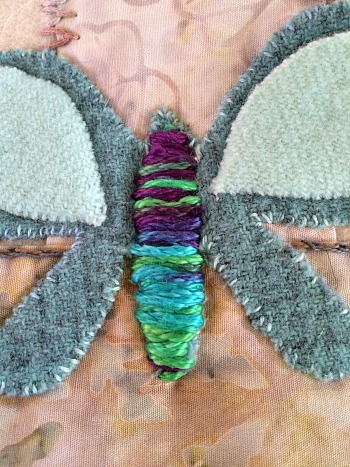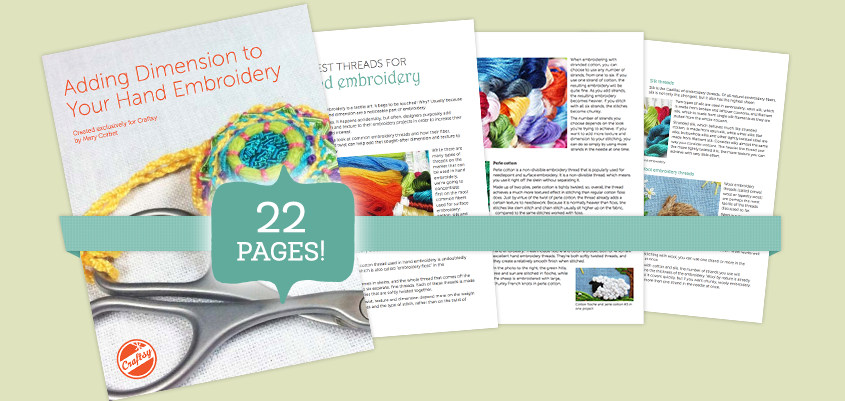It's looking like the last Craftsy class update I was able to post was back in (ahem) June. Yikes. No surprise, though, since I've had some other classes taking my attention! For at least the next few weeks, though, I should be able to make some progress on non-school-life.
New Completions
(+2)
- Easy Techniques for Zippered Bags with Joan Hawley (see my review here). This was an in-and-out class, so it didn't have a chance to show up in the "to be completed" list before it hit the "completed" list.
- Bead Embroidery with Myra Wood. I haven't had the time to post a review yet, but I've left myself a sticky note on my computer monitor to get that done. I didn't do the class project but will be using this class as reference when I add beadwork to embroidery projects.
(See? I did get some things done!)
Classes in Progress
(4)
- 2015 Craftsy Block of the Month with Jinny Beyer: Well, maybe not so much "in progress" as "languishing in a bin on my shelf. I've already bagged this one for 2015. We'll see how 2016 goes. I may remove this from "In Progress" altogether for awhile.
- The Essential Guide to Photoshop with Skott Chandler: I've decided to add this to my work task list, as the reason I bought it was for work. I'm the one that takes and/or handles all of our publicity photos. Therefore, if I need a break between all my other work tasks and can squeeze out 15 minutes or so to work on this class, I should be able to eventually get it done.
- Cook Smarter: Solutions for Weeknight Dinners with Sara Moulton: See below.
- Mobile Photography: Perfect Photos in Your Pocket with Jack Davis: See below.
Classes added this month
(+4--there was a sale, I was weak...)
- Mobile Photography: Perfect Photos in Your Pocket with Jack Davis. I'd asked Craftsy for a class like this awhile back and they told me they were working on it. It's now available: A girl's dreams can come true! I love photography--I've owned SLRs in the past, and my current digital camera is one step removed from a DSLR. The reality is, however, that I hate hauling that thing with me when I travel whereas my cell phone is always right at hand. This is especially critical when I'm staffing events for work--I need to be able to grab that great shot the second I see it, rather than scrambling to get my big ol' camera set up. Plus, the way smart phone cameras are developing, they're already better than early digital cameras were and improving with every update. And there are nifty attachments now to make them even better! So when I saw (1) this class was available and (2) it was on sale, who could resist? I've only gotten through the first couple of lessons so far but have already picked up several tips. (He discusses iOS and Droid platforms in the class.)
- Moving Between Lightroom & Photoshop with Lesa Snider. This is the perfect trifecta class with the two I already own on Lightroom and Photoshop respectively. I've only owned the Lightroom program for a few months and have really only started using it a few weeks ago (again, for work), and love what I've figured out so far. I can't wait to take the classes and really know what I'm doing!
- The New Chicken Dinner with Ian Knauer. The night after I got home from my last trip of the Insane Fall, I looked up what new cooking classes were available. I'm nesting, clearly. But I love cooking classes and didn't have any left on my list, so in the name of trying to start cooking at home again (after weeks of sandwiches, delivery, and restaurants), it seemed like a good investment.
- Cook Smarter: Solutions for Weeknight Dinners with Sara Moulton. My husband and I used to watch Sara's first show in the way back, "Cooking Live," and really liked it. We weren't as keen on her next show (slightly different format) so I sort of lost track of her. I was thrilled to see her on Craftsy, and that's made me look up her current show--Sara's Weeknight Meals on PBS. I'll need to set it up to record, I guess. In any case, I've watched the first couple of lessons in this class, remembered why I liked her so much, and am planning on making some of the recipes next week--it feels good to have time to think about cooking again!
Classes To Be Completed
Current count: (15, +3 from last report)
- 2015 Craftsy Block of the Month with Jinny Beyer
- Art Quilt Backgrounds: Beyond Log Cabin with Judith Trager
- Cook Smarter: Solutions for Weeknight Dinners with Sara Moulton
- Crazy Quilts with Allie Aller
- The Essential Guide to Lightroom with Skott Chandler
- The Essential Guide to Photoshop with Skott Chandler
- Fabric Patterning with Wax Resist with Malka Dubrawsky
- Free Motion Fillers Vol 1 with Leah Day
- Free Motion Fillers Vol 2 with Leah Day
- Free Motion Machine Embroidery with Terry White
- Machine Quilting the Home Sweet Home Quilt with Frieda Anderson
- Mobile Photography: Perfect Photos in Your Pocket with Jack Davis
- Moving Between Lightroom & Photoshop with Lesa Snider
- Pictorial Quilting Techniques with Wendy Butler Berns
- The New Chicken Dinner with Ian Knauer.
Completed Classes
Current count: 62 (+3)
- 20 Essential Cooking Techniques with Brendan McDermott
- A Modern Take on the Mother Sauces with James Peterson
- Art Quilting 101 with Wendy Butler Berns
- (The) Art of Cloth Dyeing with Jane Dunnewold
- Artisan Bread Making with Peter Reinhart
- Basics of Digital Photography with Rick Allred
- Bead Embroidery with Myra Wood
- Beyond Basic Machine Quilting with Ann Petersen
- Building Flavorful Soups with Peter Berley
- Chain of Stars Mystery Quilt with Kimberly Einmo
- Clever Cuts for Efficient Quilting with Debbie Caffrey
- Color Play for Quilters with Joen Wolfrom
- Complete Knife Skills with Brendan McDermott
- Continuous Line Quilting with Ann Petersen
- Cooking Essentials: All About Chicken with Marge Perry
- Cooking the Perfect Steak with Bruce Aidells
- Craftsy Block of the Month 2013 with Laura Nownes
- Creative Photography: Capture Life Differently with George Lange
- Creative Quilt Backs with Elizabeth Hartman
- Creative Ways with Whole Grains with Anna Bullett
- Cut to It: Strategies for Smarter Quilting with Debbie Caffrey
- Designing Modern Quilts with Weeks Ringle
- Design It, Quilt It: Freeform Quilting Techniques with Cindy Needham
- Design It, Stitch It: Hand Embroidery with Jessica Marquez
- Dot-to-Dot Quilting with Angela Walters
- Easy Techniques for Zippered Bags with Joan Hawley
- Embroidering Texture & Dimension by Hand with Sue Spargo
- Finishing School: Edges and Bindings with Mimi Dietrich
- Fire up the Fish with David Bonom
- Fun Techniques with Fabric Paints with Cindy Walter
- Free Motion Quilting a Sampler with Leah Day
- Free-Motion Quilting with Feathers with Angela Walters
- Hand-Stitched Collage Quilts with Laura Wasilowski
- Homemade Italian Pasta with Guiliano Hazan
- Homestyle Pan Sauces with Martha Holmberg
- Know Your Wool with Deborah Robson
- Learn to Sew: Simple Bags with Nicole Vasbinder
- Love Your Vegetables with Anna Bullet
- Machine Quilting with Wendy Butler Berns
- Machine Quilting Negative Space with Angela Walters
- Machine Quilting: Small Changes, Big Variety with Angela Walters
- Magical Jelly Roll Quilts with Kimberly Einmo
- Painted Pictorial Quilts with Annette Kennedy
- Pattern Free Quilt-making with Joe Cunningham
- Pictures to Pixel Quilts with Carol Sheridan
- Piece, Patch, Quilt: Basic Quiltmaking Skills with Gail Kessler
- Perfect Pizza at Home with Peter Reinhart
- Roasting Techniques Every Cook Should Know with Molly Stevens
- QuiltCon Lecture Series 2013
- Scrap Quilting with Pepper Cory
- Secrets of Slow Cooking: Mastering the Braise with Molly Stephens
- Secrets to Cooking Fish: Eight Essential Techniques with Joel Gamoran
- Sew Sturdy Travel Organizers with Annie Unrein
- Shoot It! A Product Photography Primer with Carol Sheridan
- Simple Soups from Scratch with Kathy Gunst
- Spindling from Fluff to Stuff with Drucilla Pettibone
- Stitch & Slash with Carol Ann Waugh
- Stitch it with Wool: Crewel Embroidery with Kristin Nicholas
- Strip Your Stash with Nancy Smith
- Stupendous Stitching with Carol Ann Waugh
- Thread Art with Lola Jenkins
- Travel Photography with Jad Davenport
(Note: Using any Craftsy links helps support my podcast and blog. Thank you!)















































